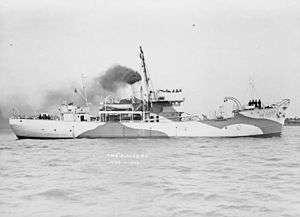Bird-class minesweeper
For the Lapwing/Bird class minesweeper, see Lapwing class minesweeper.
"Bird-class" redirects here. For the taxonomic class for birds, see class aves.
 HMS Blackbird (1943) | |
| Class overview | |
|---|---|
| Builders: | Henry Robb Ltd, Leith, Scotland. |
| Succeeded by: | Isles-class Naval trawler |
| Completed: | 45 |
| General characteristics | |
| Type: | Minesweeper |
| Displacement: | 607 standard, 923 full load |
| Length: |
|
| Beam: | 30 ft (9.1 m) |
| Draught: | 15.3 ft (4.7 m) |
| Propulsion: | 1,100 ihp (820 kW) oil |
| Speed: | 13 knots (24 km/h) |
| Complement: | 33-35 |
| Sensors and processing systems: | asdic |
| Armament: | 1 × 4 inch gun, 2 × 1 Hotchkiss, twin Lewis, 40 depth charges |
The Bird-class minesweeper was a naval trawler built to Admiralty specifications so it could function as a minesweeper. Forty-five were built. The RNZN ships were also referred to as corvettes.
The Bird class evolved from the experimental MS trawler HMS Basset, 1935, followed by HMS Mastiff, 1938, both built by Henry Robb Ltd. They were slightly larger and more powerful than these prototypes of what ultimately became the Isles' class.
Royal New Zealand Navy ships
Second World War
On 29 January 1943, in a classic duel, Kiwi and Moa rammed and wrecked the Japanese submarine I-1. On 19 August 1943 Tui and some US Kingfisher float-planes jointly sank the Japanese submarine I-17.
See also
References
- McDougall, R J (1989) New Zealand Naval Vessels. Page 59-61. Government Printing Office. ISBN 978-0-477-01399-4
This article is issued from Wikipedia - version of the 6/8/2016. The text is available under the Creative Commons Attribution/Share Alike but additional terms may apply for the media files.